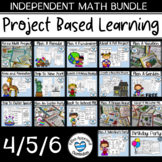4th Grade Project Based Learning Math Activity
- PDF
What educators are saying
Also included in
- Year long bundle of independent projects for gifted and talented students. Includes 17 different PBL critical thinking activities with multiple step problems. Each Project has been differentiated to best support 4th, 5th, and 6th grade with elapsed time, decimals, fractions, and interpret the remainPrice $39.00Original Price $72.00Save $33.00
Description
Teach real world math applications while letting your students research a cause and organize a fundraiser in one amazing project! This PBL is a great end of the year project that reinforces math skills while also teaching your class how they can positively make an impact. The math featured in this activity is best suited for 4th- 6th grade, and comes with multiple versions of the same page for easy differentiation.
❤️SAVE $ PURCHASING THIS ITEM IN ONE OF THE FOLLOWING BUNDLES❤️
- 4th Grade Full Year Mega Bundle
- 5th Grade Full Year Mega Bundle
- 6th Grade Full Year Mega Bundle
- Project Based Learning Math Bundle
Activities included in this project:
- Sponsor an animal - multiplying decimals or multiplying whole numbers 4.NBT.5, 5.NBT.5, 5.NBT.7
- Help a homeless shelter - division including interpreting remainders, multiplying whole numbers 4.NBT.5, 5.NBT.5
- How much impact can I have? - Analyze patterns and relationships, 5.OA.3
- Plan a fundraising carnival - Area and perimeter 4.MD.3
- Narrative Writing W.4.3, W.5.3 (4 point rubric included)
- Opinion Writing W.4.1, W.5.1 (4 point rubric included)
- Research
Love this product? Check out these Project Based Learning (PBL) resources:
Follow Kitten Approved Curriculum
Leave feedback and receive TPT credit!
Build up TPT credit by leaving feedback on our products! Submit feedback at the time of purchase or go to My Purchases for a list of what you have previously purchased. Next to the product title is a Leave Feedback button. Click and leave a rating and comment to receive your credits. Go to TPT Credits to learn how to redeem your credits on future purchases!






